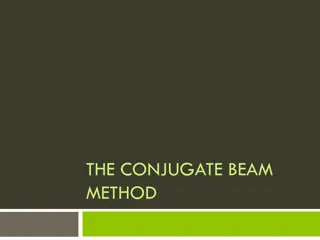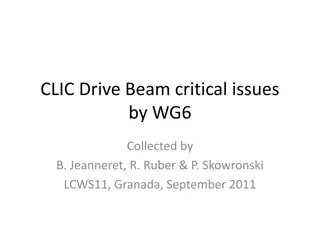Advanced Techniques for Beam Position Monitoring in Project Meetings
The project meeting on March 22, 2018, focused on detailed analyses and methods for beam position monitoring, calibration techniques, and resolution enhancement in beam position measurements using innovative waveform vectors. The process involves calculating position for a cavity BPM, waveform analysis, calibration examples, and assessing resolution by denoting measured vectors of BPM positions. Various parameters and optimization strategies are discussed for accurate and efficient beam position monitoring.
Uploaded on Nov 19, 2024 | 0 Views
Download Presentation

Please find below an Image/Link to download the presentation.
The content on the website is provided AS IS for your information and personal use only. It may not be sold, licensed, or shared on other websites without obtaining consent from the author.If you encounter any issues during the download, it is possible that the publisher has removed the file from their server.
You are allowed to download the files provided on this website for personal or commercial use, subject to the condition that they are used lawfully. All files are the property of their respective owners.
The content on the website is provided AS IS for your information and personal use only. It may not be sold, licensed, or shared on other websites without obtaining consent from the author.
E N D
Presentation Transcript
20th ATF2 Project Meeting March 22, 2018 IPBPM resolution Douglas BETT 1
Contents Position analysis and calibration methods Resolution analysis and methods Latest results 2
FONT waveforms IPB(I) IPA(I) IPC(I) IPB(Q) IPA(Q) IPC(Q) unused unused ref. diode 3
Calculating position For a cavity BPM, the charge-normalized position-dependent ? is: ? = cos?? ?+ sin?? ? where ? represents bunch charge and ? and ? are scalar representations of the ? and ? waveform vectors. Two options: Single-sample ? = ?(?) use sample ? ?=??(?) Multi-sample integrate from sample ? to sample ? ? = ?=? Note that single-sample mode is always used for ? as studies suggest integrating the charge waveform has little effect, whereas averaging ? and ? typically does improve resolution. By convention the sample to use for the charge is the one that ensures ? ~2000 ADC counts. In either case, the single-sample ? or the first and last samples of the integration range ? and ? are parameters to be optimized. 4
example?waveform first sample: 48 last sample: 68 transient mean ? waveform negative charge sample: 58 example?values ?=? ? = ?(?) ?=? ? = ?(?) 5
Calibration The relationship between actual beam position ? and ? must be determined by changing effective beam position by known amount Ideally would use IPBPM movers but recent calibrations performed by displacing beam itself using QD0FF vertical mover Calibration involves determining two parameters: ? and ? Traditionally a two-stage calibration is performed: First perform a least-squares fit of ? as a function of ? Let ? = ?? + ? , then ? = tan 1? Then fit calibration constant ? from plot of ? vs. ? Let y = ?? + ? , then ? = 1/? Alternatively the calibration could be done in a single stage: Fit ? = ??? + ??? + ? ?? ?? 1 Then ? = tan 1 and ? = 2 2+?? ?? 6
Calibration example sample 48 ? 7
Calibration parameters Scan the sample index over the entire waveform to see how ?, ? evolve. ? ? 8
Resolution Denote measured vectors of BPM positions ??, ?? and ?? where ??= ??+ ?? i.e. measured position is sum of true beam position vector ?? and random error vector ?? Predict position at one BPM as a function of positions at other two: ??= ?????+ ????? Calculate residual (difference between measurement and fit): ??= ?? ??= ?? (?????+ ?????) Standard deviation of residual vector is related to those of error vectors as follows: ??? Assuming ???= ???= ???= ?, the resolution is thus given by: Question: How are prediction coefficients determined? prediction coefficients 2??? 2??? 2= ??? 2+ ??? 2+ ??? 2 ??? 2+ ??? Answer: Using three different methods. ? = 2 1 + ??? 9
1. Geometric method Use the linear transfer matrices to express the position at the selected BPM as a function of the positions at the other two: 11??? ??? 12 12 12?? 11 ??? ??? ??? ??= ??? ??+ 12 In the case of the IP each transfer matrix corresponds to a drift: 1 0 ? 1 ? = So the prediction coefficients have very simple forms ???= 1 ??? ??? ???= 3.156 ???= 2.156, ???= 10
2. Fitting method The prediction coefficients are given by: ??? ??? =?? ?? 1 ?? i.e. the results from least-squares minimization of the residual vectors ?? 3. Minimum resolution method The prediction coefficients are determined by explicitly minimizing the resolution itself: ??? 2+ ??? ? = 2 1 + ??? 11
Comparison of methods Geometric method preferred. System fully constrained so that whichever BPM is used for prediction, a single result is obtained which is very easy to interpret. Minimal resolution method gives the minimum resolution consistent across the three BPMs for a given data set. This result is guaranteed to be an improvement on the result from the geometric method. Fitting method only one of the three to give different results depending on which BPM is used for prediction. The method does give information about the relative performance of the BPMs but the interpretation is not straightforward. If the results from the fitting method are drastically different to the value from the geometric method, it indicates a problem with the position measurement. Multi-parameter method involves using parameters other than the positions at the other BPMs (e.g. charge, ? ) to predict the position at the BPM of interest. Can be insightful. 12
Single-sample resolution jitRun2 (090218) two stage calibration Best geometric resolution = 67.6 nm (sample 54) Best minimum resolution = 38.9 nm (sample 54) single stage calibration 13
Multi-sample resolution (geo) jitRun2 (090218) Best geometric resolution = 53.6 nm (samples 50:56) Violet = first sample 68 Red = first sample 48 14
Multi-sample resolution (min) jitRun2 (090218) Best minimum resolution = 26.2 nm (samples 51:56) 15
Sample window optimization Try every possible option for the integration window to see which consistently delivers best results. Performance metric: minimal jitter of corrected beam (i.e. bunch 2, feedback on). Each horizontal line represents optimized sample window for a given file. e.g. best result was for file gainRun4_10dB_0.9_repeat. Minimum jitter found was 38.5 nm using samples 3-13 (where sample 1 denotes bunch arrival). Histogram showing which samples most frequently appear in optimized sample window e.g. out of 98 files analysed, optimized sample window included sample 9 for all but 4 files. consistent sample window: 6-12 Using this window gives 40.5 nm instead of 38.5 nm 16
Charge Scan Resolution IPA Samples: 50:57 Reference 57 09/02/2018 Improvement seen from fitting thetaIQ. Red: fitting out calibration constant. Orange: fitting out calibration constant and charge. Green: fitting out calibration constant and theta. Fit to: Position, Position and 1/q I/q and Q/q I /q, Q /q, 1/q I /q, Q /q, 1/q, self Q /q
Charge Scan Resolution IPB Red: fitting out calibration constant. Orange: fitting out calibration constant and charge. Green: fitting out calibration constant and theta. Improvement seen from fitting thetaIQ. Fit to: Position, Position and 1/q I/q and Q/q I /q, Q /q, 1/q I /q, Q /q, 1/q, self Q /q
Charge Scan Resolution IPC Red: fitting out calibration constant. Orange: fitting out calibration constant and charge. Green: fitting out calibration constant and theta. Improvement seen from fitting self Q /q. Fit to: Position, Position and 1/q I/q and Q/q I /q, Q /q, 1/q I /q, Q /q, 1/q, self Q /q
IPA Attenuation Scan Geometric resolution compared with fitting just positions and with fitting positions and charge Geometric Fit to position Fit to position and 1/q Fit to I/q and Q/q Geometric method scaled better from 50 dB than fitting method. More improvement from fitting at higher attenuations.
IPB Attenuation Scan Geometric Fit to position Fit to position and 1/q Fit to I/q and Q/q IPB shows better scaling with attenuation than the other BPMs. Disparity between geometric and fitting method does not increase significantly at higher attenuations, as was the case for the other two BPMs.
IPC Attenuation Scan Geometric Fit to position Fit to position and 1/q Fit to I/q and Q/q Fitted resolutions scale particularly badly from 50 dB for IPC. Little improvement from adding extra fit parameters. Increasing disparity between geometric and fitted resolutions with increased attenuation.
New best resolution result Single sample This study was performed at a charge ~0.5 x 1010. Dipole 10 dB attenuation. Integrating 10 samples Parameter Geometric Fitting Multi-parameter fits No. param 2 3 6 11 Y1 Y2 Y1 Y2 + const. Y1I Y2I Y1Q Y2Q + Y Ref charge + const. Y1I Y2I Y1Q Y2Q + Y Ref charge X1I X2I X1Q X2Q + X Ref charge + const Parameters used to predict vertical position at 3rd BPM. IPA Res (nm) 47 42 40 IPB Res (nm) 47 47 37 36 IPC Res (nm) 62 32 32 IPA Res (nm) 20 19 19 IPB Res (nm) 20 20 19 19 IPC Res (nm) 21 17 17 Unfortunately this result proved difficult to replicate in June, due to operational issues at higher charges from unwanted parasitic signals. Talitha Bromwich 29 June 2017 23
Sample jumps: jump3 Fortunately plenty of jumping during the Friday day shift took data (downstream board only) as soon as it happened, but noted that the upstream board was affected too Sample window can jump by a non-integer number of fast clock cycles Particularly obvious upstream: as the scan delays are typically used to shift the ADC clocks in order to catch the peaks of the signals, a 1.4 ns shift completely changes the shape of the sampled signal Also visible in the shape of the reference diode For each trigger, locate the rising edge of the reference signal By superimposing the rising edges, it is immediately evident that there are two distinct populations The red lines correspond to a sample clock lagging by 1.4 ns relative to the blue lines optimal sampling offset 1.4 ns Index of rising edge Size and frequency of jumps Time since last jump [triggers] Size of jump [samples] Too small a data set to make any definitive conclusions about the size and frequency of sample jumps 24
Conclusion Best resolution achieved to date: 20 nm New calibration procedure does not perform very well can it be refined? No easy solution for the sample jumping 25






















